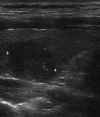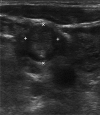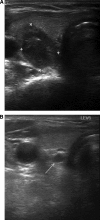Use of ultrasound in the management of thyroid cancer
- PMID: 20215358
- PMCID: PMC3227957
- DOI: 10.1634/theoncologist.2009-0324
Use of ultrasound in the management of thyroid cancer
Abstract
The use of ultrasound for thyroid cancer has evolved dramatically over the last few decades. Since the late 1960s, ultrasound has become essential in the examination of the thyroid gland with the increased availability of high-frequency linear array transducers and computer-enhanced imaging capabilities of modern day portable ultrasound equipment in a clinic- or office-based setting. As a noninvasive, rapid, and easily reproducible imaging study, ultrasound has been demonstrated to have a broadened utility beyond the simple confirmation of thyroid nodules and their sizes. Recently, office-based ultrasound has become an integral part of clinical practice, where it has demonstrated overwhelming benefits to patients being evaluated and treated for thyroid cancer. Ultrasound has become useful in the qualitative characterization of thyroid nodules based on benign or malignant features. On the basis of such classifications and the relative risk for thyroid malignancy, the need for ultrasound-guided fine-needle aspiration, preoperative and intraoperative staging, lymph node mapping, and the extent of surgery can subsequently be determined. Furthermore, ultrasound has additional value in the surveillance of patients treated for thyroid cancer.
Conflict of interest statement
The content of this article has been reviewed by independent peer reviewers to ensure that it is balanced, objective, and free from commercial bias. No financial relationships relevant to the content of this article have been disclosed by the authors or independent peer reviewers.
Figures



Similar articles
-
Developments in the use of ultrasound for thyroid cancer.Curr Opin Oncol. 2010 Jan;22(1):11-6. doi: 10.1097/CCO.0b013e3283337f16. Curr Opin Oncol. 2010. PMID: 19864951 Review.
-
Risk of malignancy in nonpalpable thyroid nodules: predictive value of ultrasound and color-Doppler features.J Clin Endocrinol Metab. 2002 May;87(5):1941-6. doi: 10.1210/jcem.87.5.8504. J Clin Endocrinol Metab. 2002. PMID: 11994321
-
The value of ultrasound-guided fine-needle aspiration biopsy (FNAB) and frozen section examination (FS) in the diagnosis of thyroid cancer.Ann Chir Gynaecol. 1999;88(2):132-5. Ann Chir Gynaecol. 1999. PMID: 10392250
-
Role of ultrasonography in thyroid disease.Otolaryngol Clin North Am. 2010 Apr;43(2):239-55, vii. doi: 10.1016/j.otc.2010.02.001. Otolaryngol Clin North Am. 2010. PMID: 20510712 Review.
-
Assessment of nondiagnostic ultrasound-guided fine needle aspirations of thyroid nodules.J Clin Endocrinol Metab. 2002 Nov;87(11):4924-7. doi: 10.1210/jc.2002-020865. J Clin Endocrinol Metab. 2002. PMID: 12414851
Cited by
-
Routine thyroglobulin, neck ultrasound and physical examination in the routine follow up of patients with differentiated thyroid cancer-Where is the evidence?Endocrine. 2018 Oct;62(1):26-33. doi: 10.1007/s12020-018-1720-3. Epub 2018 Aug 20. Endocrine. 2018. PMID: 30128957 Free PMC article. Review.
-
The role of neck ultrasound in the follow-up of low- and intermediate- risk papillary thyroid cancer.Arch Endocrinol Metab. 2022 Sept 08;66(4):481-488. doi: 10.20945/2359-3997000000485. Epub 2022 Jun 23. Arch Endocrinol Metab. 2022. PMID: 35758832 Free PMC article.
-
A UPLC Q-Exactive Orbitrap Mass Spectrometry-Based Metabolomic Study of Serum and Tumor Tissue in Patients with Papillary Thyroid Cancer.Toxics. 2022 Dec 31;11(1):44. doi: 10.3390/toxics11010044. Toxics. 2022. PMID: 36668770 Free PMC article.
-
Thyroid cancer diagnosis in the era of precision imaging.J Thorac Dis. 2020 Sep;12(9):5128-5139. doi: 10.21037/jtd.2019.08.37. J Thorac Dis. 2020. PMID: 33145090 Free PMC article. Review.
-
Intraoperative ultrasonography is useful in surgical management of neck metastases in differentiated thyroid cancers.Endocrine. 2015 Feb;48(1):248-53. doi: 10.1007/s12020-014-0287-x. Epub 2014 May 27. Endocrine. 2015. PMID: 24861473
References
-
- Milas M, Stephen A, Berber E, et al. Ultrasonography for the endocrine surgeon: A valuable clinical tool that enhances diagnostic and therapeutic outcomes. Surgery. 2005;138:1193–1201. - PubMed
-
- Papini E, Guglielmi R, Bianchini A, et al. Risk of malignancy in nonpalpable thyroid nodules: Predictive value of ultrasound and color-Doppler features. J Clin Endocrinol Metab. 2002;87:1941–1946. - PubMed
-
- Kim EK, Park CS, Chung WY, et al. New sonographic criteria for recommending fine-needle aspiration biopsy of nonpalpable solid nodules of the thyroid. AJR Am J Roentgenol. 2002;178:687–691. - PubMed
-
- Marqusee E, Benson CB, Frates MC, et al. Usefulness of ultrasonography in the management of nodular thyroid disease. Ann Intern Med. 2000;133:696–700. - PubMed
-
- Kouvaraki MA, Shapiro SE, Fornage BD, et al. Role of preoperative ultrasonography in the surgical management of patients with thyroid cancer. Surgery. 2003;134:946–955. - PubMed
MeSH terms
LinkOut - more resources
Full Text Sources
Medical
Research Materials

